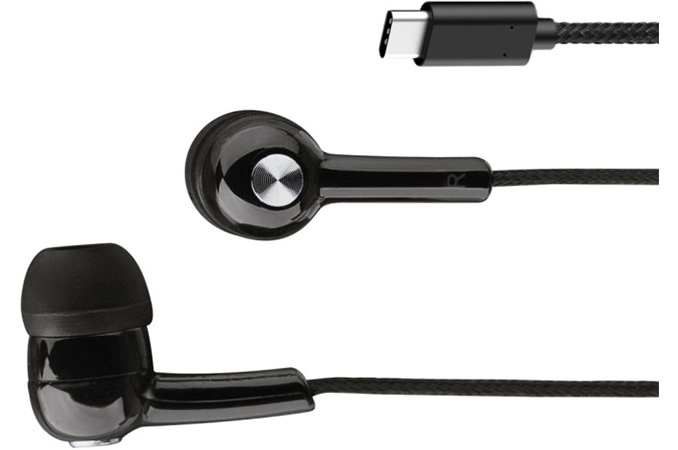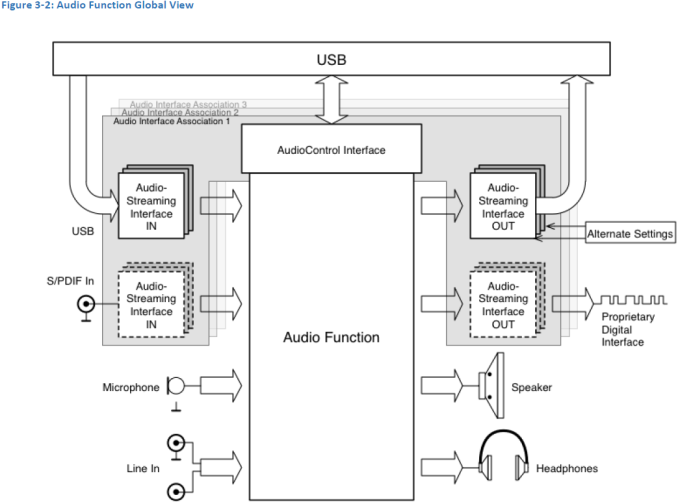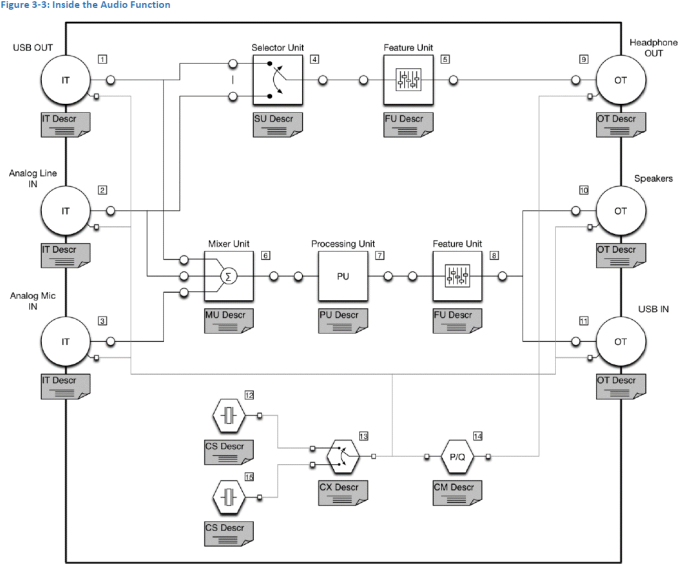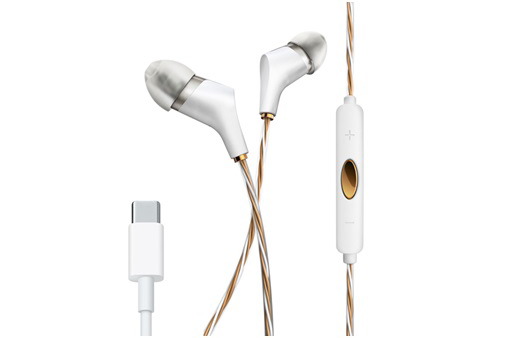USB-IF Publishes Audio over USB Type-C Specifications
by Anton Shilov on September 30, 2016 12:00 PM EST- Posted in
- Mobile
- USB-C
- USB-C Digital Audio

The USB Implementers Forum this week published the USB Audio Device Class 3.0 specification, which standardizes audio over USB Type-C interface. The new spec enables hardware makers to eliminate traditional 3.5mm mini-jacks from their devices and use USB-C ports to connect headsets and other audio equipment. Makers of peripherals can also build their audio solutions, which use USB-C instead of traditional analog connectors. Developers of the standard hope that elimination of mini-jacks will help to make devices slimmer, smarter and less power hungry.
The industry, led by Intel and some other companies, has been mulling about replacing the traditional 3.5mm mini-jack connector for some time now. The main motives for replacement were necessity to simplify internal architecture of devices by removing analog and some audio processing components from the inside (which leads to further miniaturization), minimize the number of external connectors, improve power management as well as to add smart features to headsets and other audio equipment. We discussed USB Type-C Audio Technology briefly earlier this year and mentioned that this is not the first time that the industry has tried to use USB instead of the good-old mini-jack. The important difference between contemporary initiative and attempts in the past is the fact that today the primary goal is to replace the 3.5mm jack in portable devices.
As reported, the USB Audio Device Class 3.0 specification supports both analog and digital audio. Analog audio is easy to implement and it does not impact data transfers and other functionality of USB-C cables since it uses the two secondary bus (SBU) pins. Some device makers may find the analog audio feature of the standard to be a relatively simple way to add certain smart capabilities to their headsets without major redesign of hosts. While analog USB-C audio will not help to shrink dimensions of portables, it could be particularly useful for non-mobile devices, where miniaturization is not crucial, but where port space is at a premium or where additional features either make sense (infotainment, sport equipment, etc.) or are fundamental (VR HMDs).
The USB ADC 3.0 defines minimum interoperability across analog and digital devices in order to avoid confusion of end-users because of incompatibility. In fact, all ADC 3.0-compliant hosts should support the so-called headset adapter devices, which allow to connect analog headsets to USB-C. However, digital audio is one of the primary reasons why companies like Intel wanted to develop the USB-C audio tech in the first place, hence, expect them to promote it.
According to the USB ADC 3.0 standard, digital USB-C headphones will feature special multi-function processing units (MPUs), which will, to a large degree, define the feature set and quality of headsets. The MPUs will handle host and sink synchronization (this is a key challenge for digital USB audio), digital-to-analog conversion, low-latency active noise cancellation, acoustic echo canceling, equalization, microphone automatic gain control, volume control and others. Such chips will also contain programmable amplifiers and pre-amplifiers, which are currently located inside devices. Besides, USB ADC 3.0-compatible MPUs will also support USB Audio Type-III and Type-IV formats (the latest compressed formats), but will retain compatibility with formats supported by ADC 1.0 and 2.0. Finally, among the mandated things set to be supported by USB-C Audio devices are new Power Domains (allows devices to put certain domains in sleep mode when not in use) as well as BADD (basic audio device definition) 3.0 features for saving power and simplified discovery and management of various audio equipment (each type of devices has its own BADD profile).
Over the past few months, Conexant has introduced three USB-C Audio MPUs (1, 2) for headsets, docking stations and other equipment. Assuming that these chips are compliant with the USB ADC 3.0 specs from a hardware standpoint, and the software is ready, actual devices featuring USB-C Audio could arrive in the coming months. Pricing of the first USB ADC 3.0-compliant MPUs is unknown, but in general MPU ICs do not cost too much. Moreover, as developers adopt smaller process technologies and a larger number of such chips hit the market, their prices are going to decline. In the end, it will be interesting to see where digital headphone prices end up. The MPUs will definitely add to the total bill of materials for a set of headphones, but at the same time they add new functionality as well, so the big question is how manufacturers then factor all of that into device pricing.
A number of companies, including Apple and LeEco, have already introduced smartphones that do not use traditional mini-jacks, and Google added support for USB DAC devices to Android over a year ago. The finalization of the USB ADC 3.0 spec, introduction of USB-C audio ICs, as well as design decisions of smartphone makers demonstrate that the industry is trying to eliminate 3.5mm jacks from mobile devices. The big question is whether the rest of the industry plans to do the same. It is true that portables are primary devices for music listening for many people. However, there are tens of applications which still rely on analog connectors, and hundreds of millions of people who use them either to consume or create content. To eradicate 3.5mm jacks completely, USB-C Audio promoters will have to work with thousands of vendors and this takes time. Consequently, it is too early to say that this is the end for the good-old mini-jack.
Images by Conexant, USB IF.
Source: USB IF













93 Comments
View All Comments
sonicmerlin - Friday, September 30, 2016 - link
Why do you assume the layman reading your post knows what "THD" stands for?MobiusStrip - Saturday, October 1, 2016 - link
Give us a break. The "savings" from downgrading the DAC so it's "just good enough" for the phone speakers must be vanishingly small, considering that such a product probably doesn't even exist in the correct form right now.BedfordTim - Saturday, October 1, 2016 - link
The point was to get the best quality the headphone amp must be tailored to the headphones which is valid. Clearly this only applies to high end kit and while nice to have is not related to removing the headphone jack for the remaining 99% or users.BiggerInside - Monday, October 3, 2016 - link
This is a valid point for removing the headphone jack if the choice is binary. It isn't. We've had both options on the majority of phones, now they're taking away the port most of us use and using the preference of a small minority of people to justify it. It's comparable to taking away the option to pay with cards at the grocery store (replacing card readers with Android/Apple/Samsung/Paypass readers) and saying "well, RFID payment is more secure, and you can use cash if you don't have a smartphone/RFID card." The *option* of a new system is great, but taking away the system used by most people is stupid.BiggerInside - Monday, October 3, 2016 - link
This. DACs and headphone circuits became good enough for 99% of us a decade ago. The rest of you could already use USB DACs or battery powered amps.melgross - Saturday, October 1, 2016 - link
A major concept of this for those who obviously are having problems understanding it, is that no internal DAC is needed, as the connector provides digital output. The DAC is in the headphone, or other device. So the chip that will be used internally in the phone, tablet or whatever will replace the DEAC. For those who still use analog devices, a DAC is in the cable, as Apple does it. That cable is just $9.But this is, if anything, a short term solution, because already, more wireless Bluetooth earbuds and headphones were sold, in total dollars, in 2015, than analog earbuds and headphones. That trend will continue.
Impulses - Saturday, October 1, 2016 - link
You still need an internal DAC for speaker and phone functionality tho. At best you can downgrade from a $1 part to a 0.75¢ part, and that's if it's not already built into the SoC you're using.BiggerInside - Monday, October 3, 2016 - link
Mel, if that's the motivation, why did Apple put so many redundant, expensive, obsolete DAC circuits in the iPhone7? (Cf. teardowns)Moreover, why does it make so much sense to put the same DAC in every cheap pair of headphones in the world when we could have one half-decent DAC in the phone?
haukionkannel - Friday, September 30, 2016 - link
If the Hi-Fi forums proves that audio quality is superior related to 3.5 plug... maybe... But hard to see how it could be. Maybe superior quality dac's in the headphones, but still there is really hard way to go... so Many devices support 3.5 blug. And I don't love adaptors.BiggerInside - Friday, September 30, 2016 - link
The drivers in the headphones are all still analog, because, alas, intel has yet to design an interface that will plug into the auditory processing centres of our brains.This means we can buy headphones with built-in USB DACs, but if you recall, those have actually been possible for a long time... and nothing about that development requires the elimination of the 3.5mm jack.